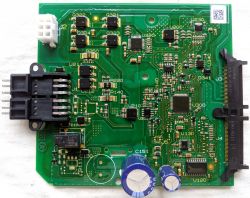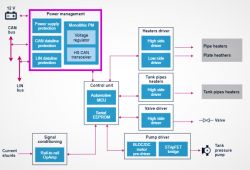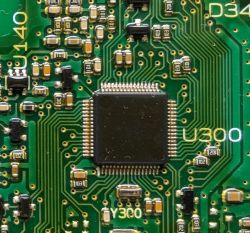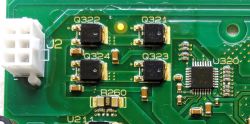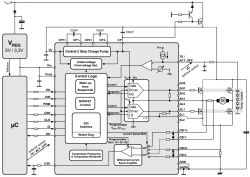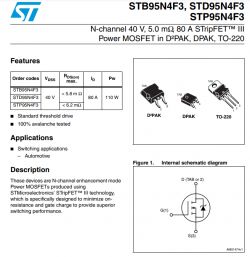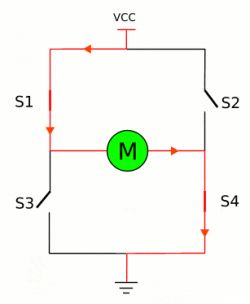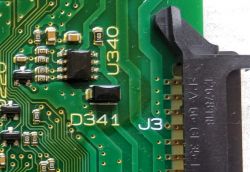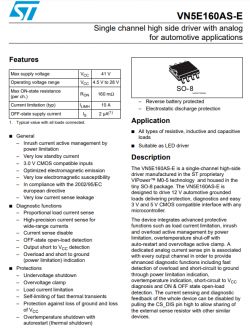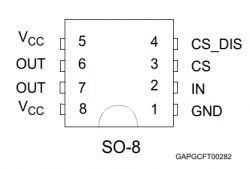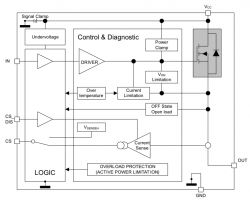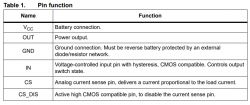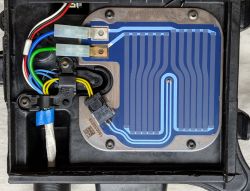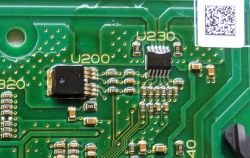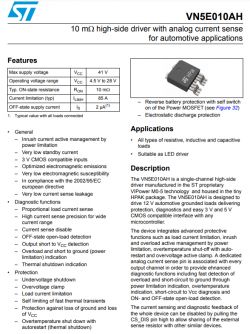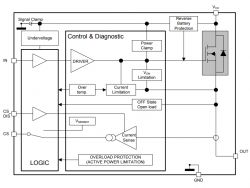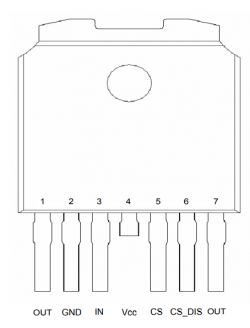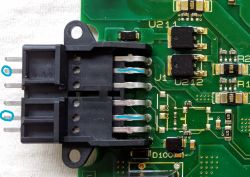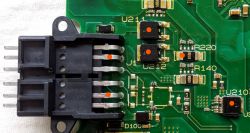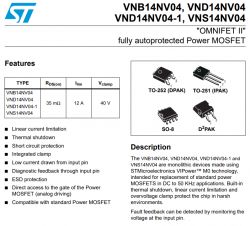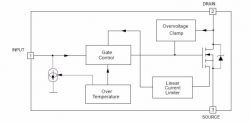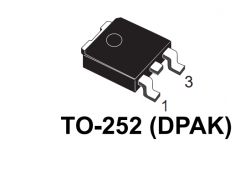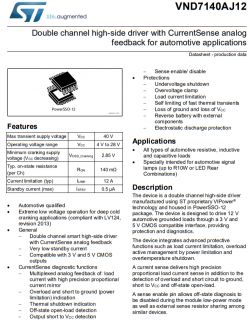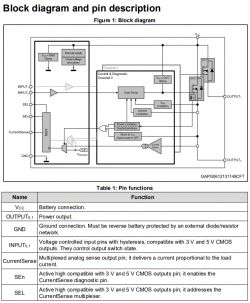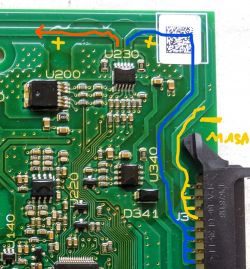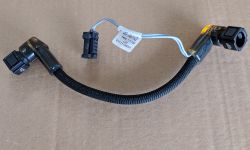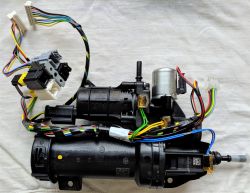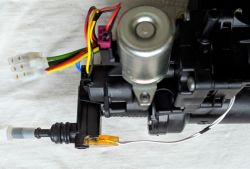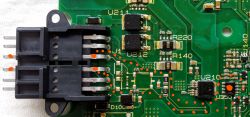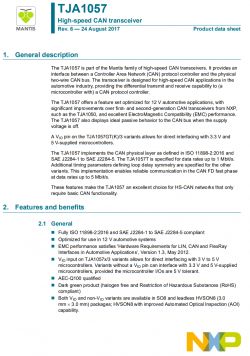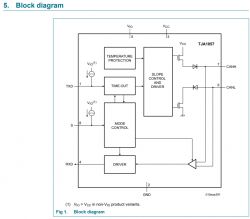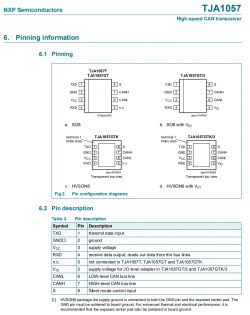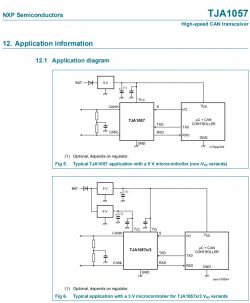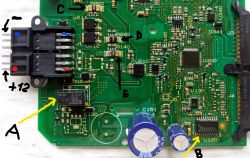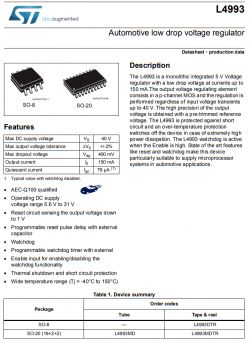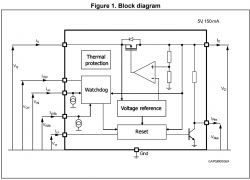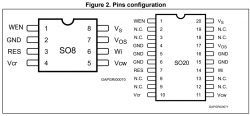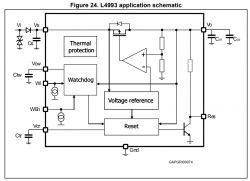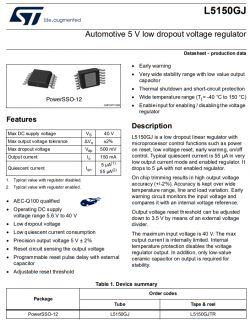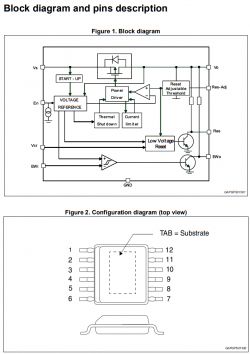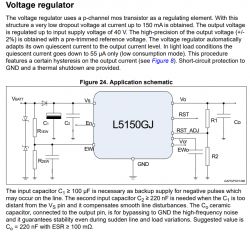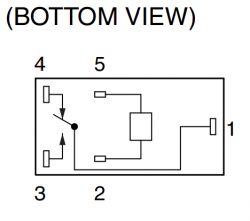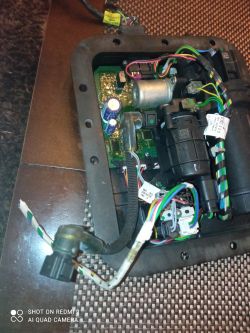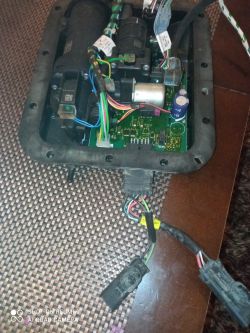In this topic I will put all the information and photos related to the repair of the AdBlue tank in the PEUGEOT BOXER III.
I hope that someone from my colleagues will find this material helpful in a similar repair.
ATTENTION VERY IMPORTANT INFORMATION:
I put this information here so that colleagues who will try to repair the tank do not make such a mistake as me.
After repairing the tank, I found the errors I had (these were text messages on the dashboard:
1) check the AdBlue system, see manual
2) check the engine
3) 300 km to stop the engine
4) orange engine light is on permanently)
They will disappear by themselves !!!! Unfortunately, I was wrong because despite the fixed AdBlue system, messages were still displayed. Clearing all the errors via the service computer has made the AdBlue system no longer reporting any errors and I have now driven 500 km since the repair and everything seems to be OK.
Update after the next month and the next 2,000 km.
Everything is great!! no errors. Gentlemen, do not be afraid of repair, if only someone has a little patience and can unscrew a few screws, it is worth trying. The description below is detailed and it's hard to make any mistakes. There is also no problem with accessing someone who will delete the errors. If someone is from the vicinity of Krosno (Podkarpackie Province), I can provide you with information on a really good specialist who can erase mistakes and help you understand the topic from this side !! There is a large selection of used tanks on the Allegro and with a high degree of probability it will be possible to "two make one good". I bought a damaged one for PLN 400 which was the donor of parts for my tank.
Not all information that I will post is 100% certain, so please correct me if someone has proven knowledge on this subject.
I am looking for service information and a diagram of the electronic board controlling the AdBlue pump.
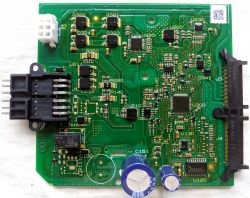
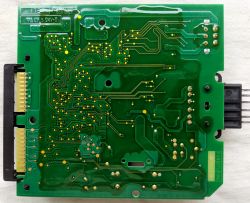
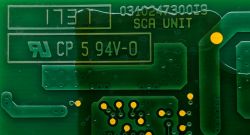

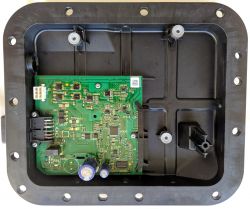
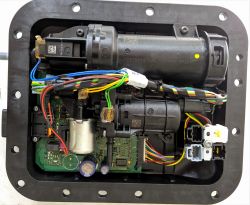
He is also looking for information about the tank venting procedure.
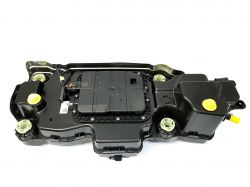
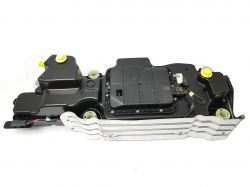
Before repairing the tank, it's worth watching this video: https://youtu.be/UmnpfIcHvlU
Removing the tank from the car
==========================
In order to repair the tank, it is necessary to remove the tank from the car. First, disconnect the battery and disconnect the cube supplying the tank marked as A.
See pictures below:
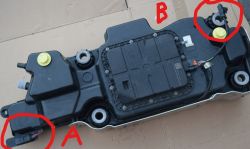
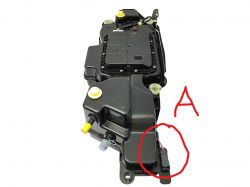

Then we need to drain the AdBlue fluid from the tank. To do this, unscrew the screw securing the plug.
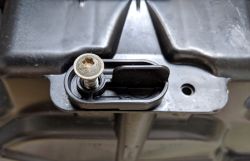
Turn the cap to the position shown in the photo below:
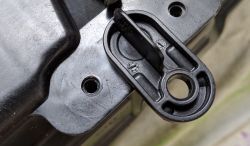
and slightly swinging movements remove the plug from its seat.
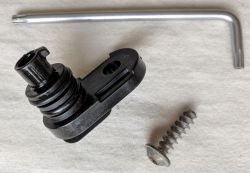
If we want to speed up the flow of fluid, please unscrew the blue filler cap AdBlue !!!!!
Then we put something under the tank so that it does not fall too much and unscrew the 4 screws securing the tank with a 13 key
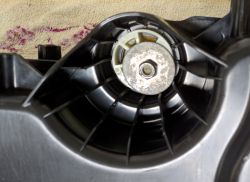

Now disconnect two tubes, one for the infusion and the other for venting (they are next to each other). You do not need any tools for this, the tubes are quick-release couplings. Just press with your fingers in the right place and the tube will pop out.
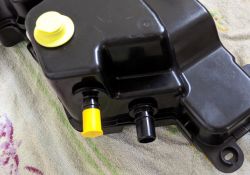
We lower the tank with one side lower to have better access to the tube and connector on the other side of the tank. Disconnect the tube and connector and take out the tank. The car can be driven, but after some time an AdBlue system failure message will appear and the countdown to immobilize the car will start. We still have the possibility to travel 400 km.
Below is a view of the chassis after removing the tank:
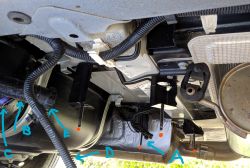
The tank is screwed to the black frame finished with four pins (red points) with 4 screws.
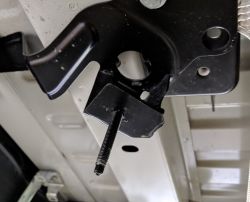
A - quick coupler on the conduit which supplies urea under pressure to the injector. Next to it, there is a cube for powering the heating circuit.
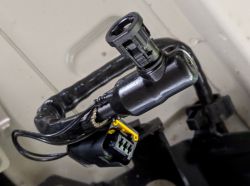
B - The urea filler tube with the end extends upward for the urea filler.
E - tube quick coupler B.
C - quick coupler of the tank venting tube.
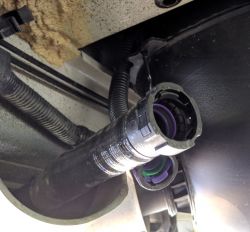
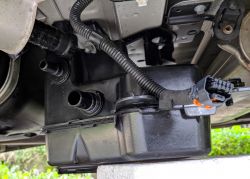
D - tank supply cable with a plug.
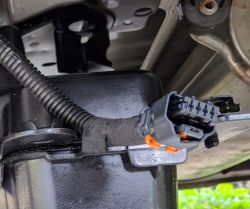
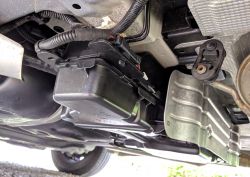
Description of the electronic board:
The electronics located on the board manage the operation of the tank and send information on the status of the tank via the CAN bus to the car's central computer. It reads data from two temperature sensors, one pressure sensor and one fluid level sensor in the tank. It controls one pump, one solenoid valve, and seven urea heating circuits.
The board has 4 connectors for communication with the above-mentioned elements. See the photo of the board (connectors J1 and J2 and two edge connectors J3 and J4)
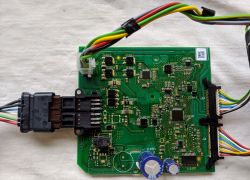
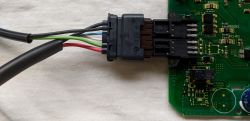
Description of J1 pins in the order shown in the photo from top to bottom:
1 - thick black - tank feed - minus
2 - thinner black - heating of the urea tube between the tank and the urea injector - minus
3 - thin blue CAN bus
4 - thin white CAN bus
5 - green - heating of the urea tube between the tank and the urea injector - plus
6 - thick red - power supply to the tank + 12V
A urea hose runs between the AdBlue tank (near the fuel tank) and the urea injector (near the engine) (see figure below in the appendix - item marked as 26), which is prone to freezing in winter. Urea freezes at a temperature below -11 "C and therefore the entire length of the urea tube is heated by a resistance wire fused into the tube. Pins 2 and 5 of J1 junction supply this resistance wire. It is one of the seven urea heating circuits and the only external circuit for the rest The 6 urea heating circuits are located inside the AdBlue tank.
NOTE IMPORTANT: supplying the tank + 12 V the connector J1 (6 - red) appears after turning the key and supplies the tank. The car's central computer waits for a CAN response from the AdBlue tank. If there is no answer, the car's computer disconnects the + 12V power supply of the tank. It may be misunderstood by the car repairman that the cause of the problem is a lack of +12 power on connector J1. To sum up, if there is no communication between the tank and the car, or the tank is disconnected and removed, the voltage will appear on the J1 to 6 (+ 12V) connectors only for a few seconds and then disappear.
J2 pinout description (see photo)
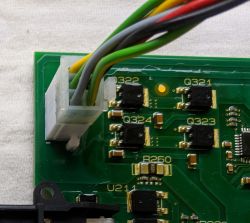
1) yellow-green steam (100W heater power supply) urea heating in the tank near the filter through which the pump sucks urea.
The heater is an 8X8 cm plate with a system of resistance paths and is used to defrost the local urea in the tank near the urea intake by the pump. In severe frost, the urea in the entire tank (16l) may freeze and this heating plate locally melts the ice near the filter so that the pump can suck in urea. The heater is located in the non-removable part of the tank and it is impossible to get to it without cutting the tank open !!!!! Like a level sensor and two temperature sensors !!!!
A plate heater is the second heating element out of seven.
2) pair of black (minus) - green-yellow (plus) wires power supply to the pump motor.
3) the gray-red pair is the tube heating feed between the urea-immersed filter and the pump (see photo below). This is the third heating element out of seven.
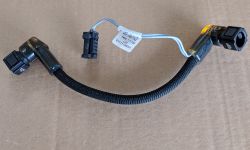
Description of the pins of connector J3, the order shown in the photo from bottom to top. Downstairs is # 1 !!!!!! (look at the picture)
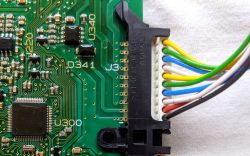
contact No. 1 (first from the bottom !!!) black ground - solenoid valve control.
red contact no. 2 plus red - solenoid valve control.
the next contacts supply the four remaining out of the seven heating circuits:
- white circuit - pair 3 and 7 (white wires)
- blue circuit - pair 4 and 8 (blue wires)
- green circuit - pair 5 and 9 (green wires)
- yellow circuit - pair 6 and 10 (yellow wires)
As can be seen from the track system, the four above-mentioned heating systems are turned on together with the same signal and always work together. If one is shorted, the other three will be short !!!!
Four of the above-mentioned heating circuits (white, blue, green and yellow) heat the 4 urea flow points (see photos below)

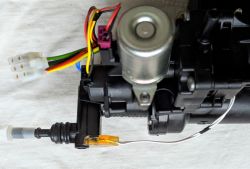
- the white heating circuit heats urea in a tube (elbow) at the outlet from the tank.
- the green heating circuit heats the urea pump.
- yellow heating circuit heats up the place near the solenoid valve and pressure sensor.
- blue heating circuitheats the urea accumulator (a small container with a glass capacity in which urea is at a pressure of about 5-6 bar)
Description of pins of connector J4 in the order shown in the photo from bottom to top. Downstairs is # 1 !!!!!! (look at the picture)
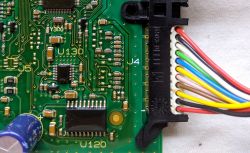
contact no. 1 (first from the bottom !!!) red supply plus - urea pressure sensor.
contact no. 2 black power supply minus - pressure sensor.
contact no. 3 yellow signal (data) from pressure sensor.
The sensor measures the urea pressure supplied to the injector (it should be about 5-6 bar). The pump pumps the urea into a small tank called an accumulator in which the urea is under a pressure of 5-6 bar. In the following, I will describe the principle of operation in detail.
-------------------------------------------------- -------------------------------------------------- -------------------------------------------------- --------
brown contact no. 4 - the temperature sensor is located near the filter and measures the urea temperature in the tank at the point where it is taken by the pump.
light brown contact no.5 - temperature sensor - other end (pair 4 and 5)
Note: The temperature sensor is located at the bottom of the tank and there is no access to it !!! You have to cut open the tank to get to it !!!!
-------------------------------------------------- -------------------------------------------------- -------------------------------------------------- ---------
contact No. 6 yellow - the temperature sensor is located in the central part of the heating plate (described above) and measures the temperature of the heating plate itself. (measures the temperature of the heating element, not the urea temperature like the one described above !!!)
contact No. 7 blue - temperature sensor - other end (pair 6 and 7)
Note: as above - no access to the sensor, you have to cut the tank !!!!
-------------------------------------------------- -------------------------------------------------- -------------------------------------------------- ---------
contact no. 8 signal (data) - level sensor (hall effect sensor cooperates with a float in which there is a permanent magnet).
contact No. 9 white - not used !!!
contact no.10 black power supply to the level sensor minus (ground)
red contact no. 11 power supply for the plus level sensor
Note: The level sensor is located next to the heating plate at the bottom of the tank and cannot be accessed !!! You have to cut open the tank
to get to it !!!!
Below are photos of sensors and a heating plate. Access to these items is not available !!! You need to cut open the tank and remove a part of the housing to make the sensors visible because they are tightly closed in a plastic can.
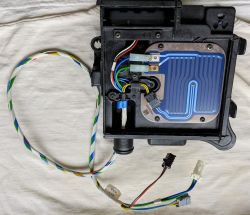
100W heating plate and photo of the temperature sensor placed directly on the heating plate:
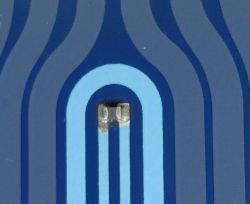
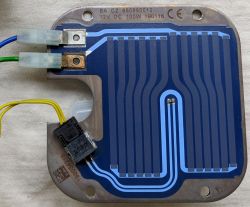
Temperature sensor that measures the temperature of the fluid (urea) near the filter through which the pump takes urea:


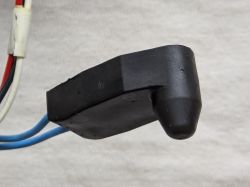
The place where the urea temperature sensor is located is marked in red. It is the outside of the sensor box that is in direct contact with the urea. The sensor measures the temperature of the urea through the wall of the box, therefore there is a bulge here for better contact with the liquid.
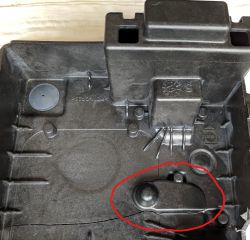
The photo also shows the float chamber of the urea level sensor.
The urea level sensor consists of a chamber in which a float with a permanent magnet is placed (the chamber is in direct contact with urea and a plate with a Hall sensor which is closed in a sealed housing:
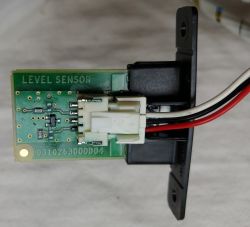
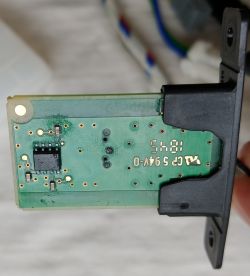
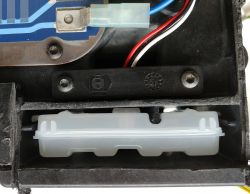
Float with a permanent magnet visible inside:
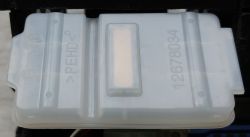
As I wrote earlier, we cannot access the above-mentioned sensors without cutting the tank open. We can measure only 3 connection cubes at the end of the wiring harness that enters the chamber located at the top of the tank, where the electronics and the pump are located. The yellow element is the port where the pump takes AdBlue from the tank, and the filter is attached to the port on the other side.
Look at the picture:
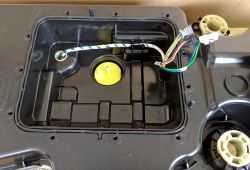
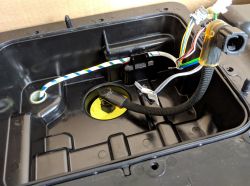
Photo of a bundle with 3 cubes:
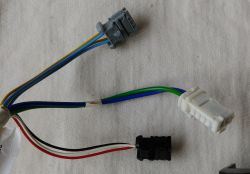
White cube - power supply to the heating plate
Black cube - fluid level sensor
Gray cube - two temperature sensors (yellow cables - temperature sensor on the heating plate, blue cables - AdBlue fluid temperature sensor)
TESTING elements that are not accessible without cutting the tank open.
================================================== ==============
We test on the above-mentioned white, black and gray cubes
The white cube comes with two slightly thicker wires directly from the urea heating plate.
Board power 100 W
12 V power supply
Measurement with an ohmmeter should show about 1.8 ohms both ways, of course. There are no security etc. on the way.
Two pairs of wires enter the gray cube:
yellow steam from the temperature sensor located in the center of the heating plate - about 11 k ohms at a temperature of about 17 degrees C.
blue steam urea temperature sensor - about 3 kilohms in the above-mentioned temperature.
The black cube includes three wires from the level sensor.
black minus
red plus
white signal
the fluid level sensor is a hall effect sensor. It is made of several elements. We can only test the resistance between the wires. In the direction of conduction:
red-white - about 900 ohms
red-black - about 900 ohms
white - black - about 800 ohms
high resistance in the obstructive direction.
Photo of the chamber with sensors seen from above (sensors and heating plate are on the other side):

A - float chamber.
B - fluid level sensor located on the other side.
C - urea temperature sensor located on the underside.
D - marked place where there is a heating plate on the bottom.
The chamber is covered with a white plate with a spring. Inside the spring there is a filter through which urea is collected by the pump:
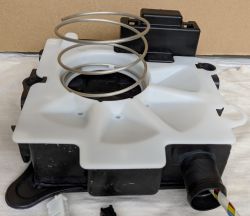
Description of the AdBlue level sensor operation.
===========================================
The tank has a capacity of about 16 liters, which allows you to drive about 6,000 km without refueling with urea.
The level sensor is placed in the tank at about halfway up the tank and the float can move about 6 cm up and down in its chamber. For this reason, the sensor does not read the fluid level in the tank from 0 to 16 liters, but only works within a certain range.
If there are 8 or more liters of urea in the tank, the float is always in the maximum upper position and it is not possible to read exactly how much urea is in the tank (e.g. it can be 8 or it can be 16 liters !!!). In such a case, the electronics receives a signal that the urea is more than 8 liters (how much more? He does not know it !!) He only recognizes that everything is OK for sure. No message will appear on the instrument panel until the urea level is below 8 liters !!
When the urea level drops below 8 liters, the float begins to slowly drop and the car receives information that there is urea left in the tank for 2400 km, this causes the AdBlue indicator to light for a moment and the message that we can drive another 2400 km appears. As the float goes down, further messages appear that we can cover less kilometers. This happens until the swimmer reaches the bottom position, then a message appears that we can still run 600 km. In this case, the AdBlue light is on all the time and a message will appear every 50 km that you need to add AdBlue.
After driving 600 km, a message will appear that the car has been blocked. You need to add at least 4 liters of fluid to unlock the car.
Description of the operation of the hydraulic system located in the tank
================================================
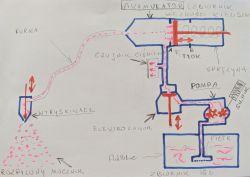
The hydraulic system includes:
1) a urea filter located in the non-removable part of the tank.
2) Pump driven by a small DC electric motor.
3) solenoid valve.
4) pressure sensor.
5) urea accumulator (a small container the size of a glass in which urea is under a pressure of about 5-6 bar, one side of which is a plunger on which pressure is applied by a pre-compressed spring). The structure of the urea accumulator resembles a syringe in which a pre-compressed spring presses the plunger. When charging the battery, the piston moves under the influence of the AdBlue fluid pumped by the pump against the pressure generated by the spring. Due to the spring, the urea in the accumulator remains under a constant pressure of 6 bar. This solution means that the electric pump is not working all the time, it is only started for a moment to replenish the urea in the battery.
The principle of operation of the entire urea dosing system is quite simple. The urea is taken from the reservoir by the pump and pumped into the accumulator. The pump runs until it builds up a pressure of about 6 bar in the accumulator. The pressure in the accumulator is monitored by a pressure sensor. To prevent urea (which is pressurized) from flowing back into the reservoir from the battery, there is a solenoid valve between the battery and the pump.
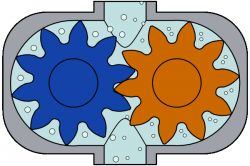
Click on the picture.
The gear pump is not a tight pump, I mean the state when the pump does not pump itthe liquid already pumped into the battery can easily squeeze between the gears and return to the tank.
For this reason, a solenoid valve is required which in this case prevents the backflow of urea already pumped into the accumulator.
The following duty cycle is performed:
The pressure sensor constantly monitors the pressure in the accumulator. While driving, the urea under pressure is fed to the urea injector, which injects subsequent portions as needed, which causes a drop in urea pressure in the accumulator. If the pressure drops to the lower limit, the solenoid valve opens and the pump recharges the battery. After charging the battery, the pump stops and the solenoid valve closes. This state continues until the urea pressure in the accumulator drops again, and the cycle repeats.

Picture description:
A + B - battery
part A - round box contains a spring with a piston.
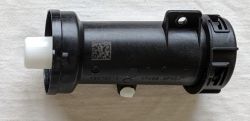
part B - contains a chamber inside the size of a glass filled with urea. One side of the chamber is a plunger.
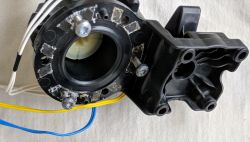
Between parts A and B there is a metal ring connecting both parts and a rubber cap is placed on the piston, which acts as a seal. It prevents urea from getting into the spring can. See pictures below:
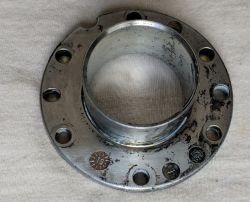
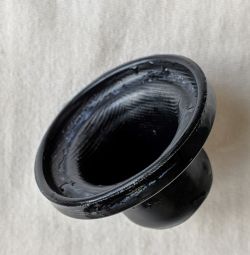
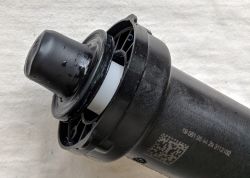
In the photos below, the damaged engine (it was flooded with urea for a long time and was subject to corrosion):
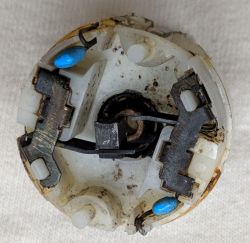
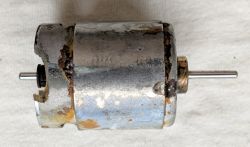
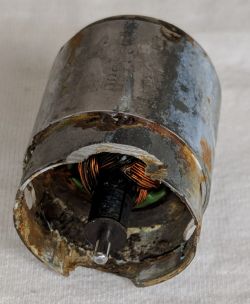
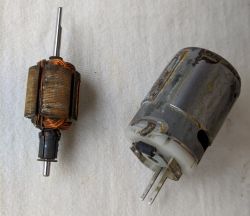
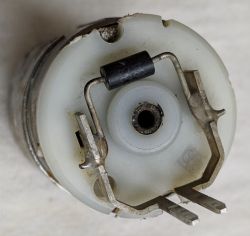
The protective diode visible in the photo is TRANSIL BIDIRECTIONAL P6KE
Wikipedia:
Transil (Transient Voltage Suppressor, TVS) - a specialized diode that protects sensitive electronic components from the effects of overvoltages, often used to suppress overvoltages and high voltage pulses. It works like a varistor, but is much faster than it. After exceeding the threshold voltage, it begins to conduct rapidly. The main advantage of the TRANSIL is a very short reaction time - on the order of 1 picosecond. The popular 1.5KE series allows you to dissipate 1500 W of peak power for a short time. Transil can be both unidirectional and bidirectional.
Pump:
It is a simple gear pump. One rack is driven by the motor (shown above) and the other rack is driven directly by the first rack. See https://pl.wikipedia.org/wiki/Pompa_z%C4%99bata
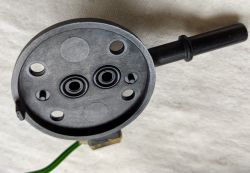
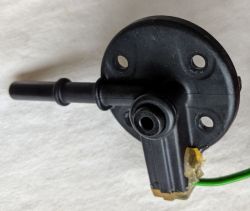
The outer wall of the pump contains a heating element (green circuit). Two visible holes secured with O-rings. With one, urea is sucked into the pump, and with the other, urea is forced through the pump gears to the accumulator.
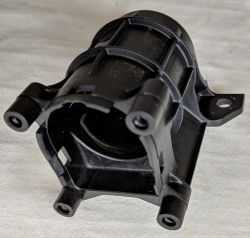
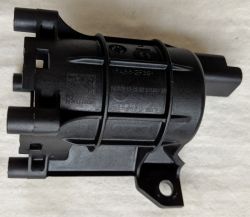
The pump body in which the motor is located.

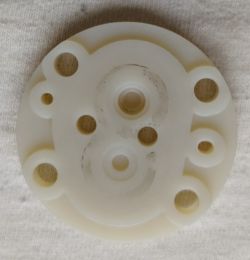
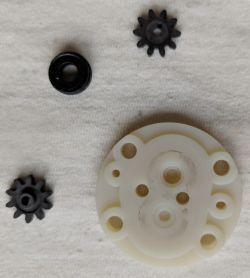
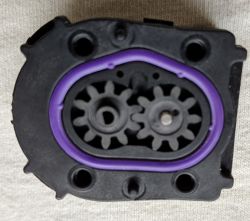

Pump chamber in which two gears work. Sealing - purple O-ring.
A pressure sensor:
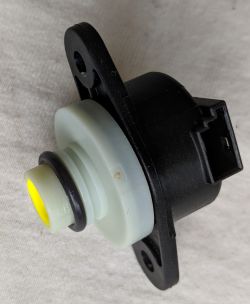
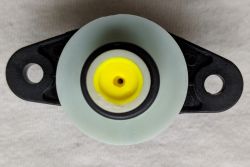
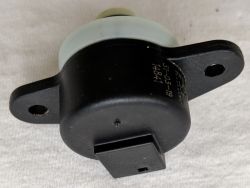
The socket in which the pressure sensor is placed:

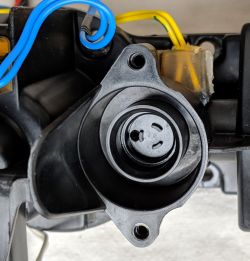
The sensor has a sealing O-ring, is pushed into the socket and is secured with two screws.
There is a problem with unscrewing these screws because they have unusual heads.
Electrovalve:
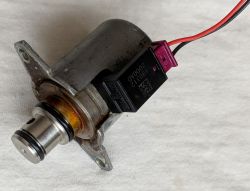
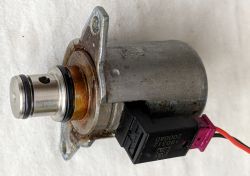
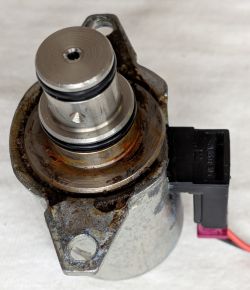
Solenoid valve seat:
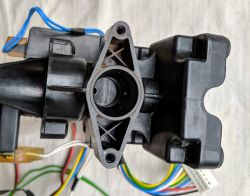
Similar assembly as the pressure sensor and the same problem with unscrewing by unusual screw heads !!!
All the above-mentioned elements are mounted to the body made of plastic with channels through which urea flows from the pump to the accumulator. Due to the large number of hydraulic connections (O-rings and quick couplings), urea leaks may appear which causes corrosion. The disassembly of the tank is simple, no special tools are required. All screws have torx heads except the four I wrote about earlier. You have to keep the assembly very clean because there are many seals on the O-rings and even a hair that comes under the O-ring can cause leakage.
cdn ..
I hope that someone from my colleagues will find this material helpful in a similar repair.
ATTENTION VERY IMPORTANT INFORMATION:
I put this information here so that colleagues who will try to repair the tank do not make such a mistake as me.
After repairing the tank, I found the errors I had (these were text messages on the dashboard:
1) check the AdBlue system, see manual
2) check the engine
3) 300 km to stop the engine
4) orange engine light is on permanently)
They will disappear by themselves !!!! Unfortunately, I was wrong because despite the fixed AdBlue system, messages were still displayed. Clearing all the errors via the service computer has made the AdBlue system no longer reporting any errors and I have now driven 500 km since the repair and everything seems to be OK.
Update after the next month and the next 2,000 km.
Everything is great!! no errors. Gentlemen, do not be afraid of repair, if only someone has a little patience and can unscrew a few screws, it is worth trying. The description below is detailed and it's hard to make any mistakes. There is also no problem with accessing someone who will delete the errors. If someone is from the vicinity of Krosno (Podkarpackie Province), I can provide you with information on a really good specialist who can erase mistakes and help you understand the topic from this side !! There is a large selection of used tanks on the Allegro and with a high degree of probability it will be possible to "two make one good". I bought a damaged one for PLN 400 which was the donor of parts for my tank.
Not all information that I will post is 100% certain, so please correct me if someone has proven knowledge on this subject.
I am looking for service information and a diagram of the electronic board controlling the AdBlue pump.






He is also looking for information about the tank venting procedure.


Before repairing the tank, it's worth watching this video: https://youtu.be/UmnpfIcHvlU
Removing the tank from the car
==========================
In order to repair the tank, it is necessary to remove the tank from the car. First, disconnect the battery and disconnect the cube supplying the tank marked as A.
See pictures below:



Then we need to drain the AdBlue fluid from the tank. To do this, unscrew the screw securing the plug.

Turn the cap to the position shown in the photo below:

and slightly swinging movements remove the plug from its seat.

If we want to speed up the flow of fluid, please unscrew the blue filler cap AdBlue !!!!!
Then we put something under the tank so that it does not fall too much and unscrew the 4 screws securing the tank with a 13 key


Now disconnect two tubes, one for the infusion and the other for venting (they are next to each other). You do not need any tools for this, the tubes are quick-release couplings. Just press with your fingers in the right place and the tube will pop out.

We lower the tank with one side lower to have better access to the tube and connector on the other side of the tank. Disconnect the tube and connector and take out the tank. The car can be driven, but after some time an AdBlue system failure message will appear and the countdown to immobilize the car will start. We still have the possibility to travel 400 km.
Below is a view of the chassis after removing the tank:

The tank is screwed to the black frame finished with four pins (red points) with 4 screws.

A - quick coupler on the conduit which supplies urea under pressure to the injector. Next to it, there is a cube for powering the heating circuit.

B - The urea filler tube with the end extends upward for the urea filler.
E - tube quick coupler B.
C - quick coupler of the tank venting tube.


D - tank supply cable with a plug.


Description of the electronic board:
The electronics located on the board manage the operation of the tank and send information on the status of the tank via the CAN bus to the car's central computer. It reads data from two temperature sensors, one pressure sensor and one fluid level sensor in the tank. It controls one pump, one solenoid valve, and seven urea heating circuits.
The board has 4 connectors for communication with the above-mentioned elements. See the photo of the board (connectors J1 and J2 and two edge connectors J3 and J4)


Description of J1 pins in the order shown in the photo from top to bottom:
1 - thick black - tank feed - minus
2 - thinner black - heating of the urea tube between the tank and the urea injector - minus
3 - thin blue CAN bus
4 - thin white CAN bus
5 - green - heating of the urea tube between the tank and the urea injector - plus
6 - thick red - power supply to the tank + 12V
A urea hose runs between the AdBlue tank (near the fuel tank) and the urea injector (near the engine) (see figure below in the appendix - item marked as 26), which is prone to freezing in winter. Urea freezes at a temperature below -11 "C and therefore the entire length of the urea tube is heated by a resistance wire fused into the tube. Pins 2 and 5 of J1 junction supply this resistance wire. It is one of the seven urea heating circuits and the only external circuit for the rest The 6 urea heating circuits are located inside the AdBlue tank.
NOTE IMPORTANT: supplying the tank + 12 V the connector J1 (6 - red) appears after turning the key and supplies the tank. The car's central computer waits for a CAN response from the AdBlue tank. If there is no answer, the car's computer disconnects the + 12V power supply of the tank. It may be misunderstood by the car repairman that the cause of the problem is a lack of +12 power on connector J1. To sum up, if there is no communication between the tank and the car, or the tank is disconnected and removed, the voltage will appear on the J1 to 6 (+ 12V) connectors only for a few seconds and then disappear.
J2 pinout description (see photo)

1) yellow-green steam (100W heater power supply) urea heating in the tank near the filter through which the pump sucks urea.
The heater is an 8X8 cm plate with a system of resistance paths and is used to defrost the local urea in the tank near the urea intake by the pump. In severe frost, the urea in the entire tank (16l) may freeze and this heating plate locally melts the ice near the filter so that the pump can suck in urea. The heater is located in the non-removable part of the tank and it is impossible to get to it without cutting the tank open !!!!! Like a level sensor and two temperature sensors !!!!
A plate heater is the second heating element out of seven.
2) pair of black (minus) - green-yellow (plus) wires power supply to the pump motor.
3) the gray-red pair is the tube heating feed between the urea-immersed filter and the pump (see photo below). This is the third heating element out of seven.

Description of the pins of connector J3, the order shown in the photo from bottom to top. Downstairs is # 1 !!!!!! (look at the picture)

contact No. 1 (first from the bottom !!!) black ground - solenoid valve control.
red contact no. 2 plus red - solenoid valve control.
the next contacts supply the four remaining out of the seven heating circuits:
- white circuit - pair 3 and 7 (white wires)
- blue circuit - pair 4 and 8 (blue wires)
- green circuit - pair 5 and 9 (green wires)
- yellow circuit - pair 6 and 10 (yellow wires)
As can be seen from the track system, the four above-mentioned heating systems are turned on together with the same signal and always work together. If one is shorted, the other three will be short !!!!
Four of the above-mentioned heating circuits (white, blue, green and yellow) heat the 4 urea flow points (see photos below)


- the white heating circuit heats urea in a tube (elbow) at the outlet from the tank.
- the green heating circuit heats the urea pump.
- yellow heating circuit heats up the place near the solenoid valve and pressure sensor.
- blue heating circuitheats the urea accumulator (a small container with a glass capacity in which urea is at a pressure of about 5-6 bar)
Description of pins of connector J4 in the order shown in the photo from bottom to top. Downstairs is # 1 !!!!!! (look at the picture)

contact no. 1 (first from the bottom !!!) red supply plus - urea pressure sensor.
contact no. 2 black power supply minus - pressure sensor.
contact no. 3 yellow signal (data) from pressure sensor.
The sensor measures the urea pressure supplied to the injector (it should be about 5-6 bar). The pump pumps the urea into a small tank called an accumulator in which the urea is under a pressure of 5-6 bar. In the following, I will describe the principle of operation in detail.
-------------------------------------------------- -------------------------------------------------- -------------------------------------------------- --------
brown contact no. 4 - the temperature sensor is located near the filter and measures the urea temperature in the tank at the point where it is taken by the pump.
light brown contact no.5 - temperature sensor - other end (pair 4 and 5)
Note: The temperature sensor is located at the bottom of the tank and there is no access to it !!! You have to cut open the tank to get to it !!!!
-------------------------------------------------- -------------------------------------------------- -------------------------------------------------- ---------
contact No. 6 yellow - the temperature sensor is located in the central part of the heating plate (described above) and measures the temperature of the heating plate itself. (measures the temperature of the heating element, not the urea temperature like the one described above !!!)
contact No. 7 blue - temperature sensor - other end (pair 6 and 7)
Note: as above - no access to the sensor, you have to cut the tank !!!!
-------------------------------------------------- -------------------------------------------------- -------------------------------------------------- ---------
contact no. 8 signal (data) - level sensor (hall effect sensor cooperates with a float in which there is a permanent magnet).
contact No. 9 white - not used !!!
contact no.10 black power supply to the level sensor minus (ground)
red contact no. 11 power supply for the plus level sensor
Note: The level sensor is located next to the heating plate at the bottom of the tank and cannot be accessed !!! You have to cut open the tank
to get to it !!!!
Below are photos of sensors and a heating plate. Access to these items is not available !!! You need to cut open the tank and remove a part of the housing to make the sensors visible because they are tightly closed in a plastic can.

100W heating plate and photo of the temperature sensor placed directly on the heating plate:


Temperature sensor that measures the temperature of the fluid (urea) near the filter through which the pump takes urea:



The place where the urea temperature sensor is located is marked in red. It is the outside of the sensor box that is in direct contact with the urea. The sensor measures the temperature of the urea through the wall of the box, therefore there is a bulge here for better contact with the liquid.

The photo also shows the float chamber of the urea level sensor.
The urea level sensor consists of a chamber in which a float with a permanent magnet is placed (the chamber is in direct contact with urea and a plate with a Hall sensor which is closed in a sealed housing:



Float with a permanent magnet visible inside:

As I wrote earlier, we cannot access the above-mentioned sensors without cutting the tank open. We can measure only 3 connection cubes at the end of the wiring harness that enters the chamber located at the top of the tank, where the electronics and the pump are located. The yellow element is the port where the pump takes AdBlue from the tank, and the filter is attached to the port on the other side.
Look at the picture:


Photo of a bundle with 3 cubes:

White cube - power supply to the heating plate
Black cube - fluid level sensor
Gray cube - two temperature sensors (yellow cables - temperature sensor on the heating plate, blue cables - AdBlue fluid temperature sensor)
TESTING elements that are not accessible without cutting the tank open.
================================================== ==============
We test on the above-mentioned white, black and gray cubes
The white cube comes with two slightly thicker wires directly from the urea heating plate.
Board power 100 W
12 V power supply
Measurement with an ohmmeter should show about 1.8 ohms both ways, of course. There are no security etc. on the way.
Two pairs of wires enter the gray cube:
yellow steam from the temperature sensor located in the center of the heating plate - about 11 k ohms at a temperature of about 17 degrees C.
blue steam urea temperature sensor - about 3 kilohms in the above-mentioned temperature.
The black cube includes three wires from the level sensor.
black minus
red plus
white signal
the fluid level sensor is a hall effect sensor. It is made of several elements. We can only test the resistance between the wires. In the direction of conduction:
red-white - about 900 ohms
red-black - about 900 ohms
white - black - about 800 ohms
high resistance in the obstructive direction.
Photo of the chamber with sensors seen from above (sensors and heating plate are on the other side):

A - float chamber.
B - fluid level sensor located on the other side.
C - urea temperature sensor located on the underside.
D - marked place where there is a heating plate on the bottom.
The chamber is covered with a white plate with a spring. Inside the spring there is a filter through which urea is collected by the pump:

Description of the AdBlue level sensor operation.
===========================================
The tank has a capacity of about 16 liters, which allows you to drive about 6,000 km without refueling with urea.
The level sensor is placed in the tank at about halfway up the tank and the float can move about 6 cm up and down in its chamber. For this reason, the sensor does not read the fluid level in the tank from 0 to 16 liters, but only works within a certain range.
If there are 8 or more liters of urea in the tank, the float is always in the maximum upper position and it is not possible to read exactly how much urea is in the tank (e.g. it can be 8 or it can be 16 liters !!!). In such a case, the electronics receives a signal that the urea is more than 8 liters (how much more? He does not know it !!) He only recognizes that everything is OK for sure. No message will appear on the instrument panel until the urea level is below 8 liters !!
When the urea level drops below 8 liters, the float begins to slowly drop and the car receives information that there is urea left in the tank for 2400 km, this causes the AdBlue indicator to light for a moment and the message that we can drive another 2400 km appears. As the float goes down, further messages appear that we can cover less kilometers. This happens until the swimmer reaches the bottom position, then a message appears that we can still run 600 km. In this case, the AdBlue light is on all the time and a message will appear every 50 km that you need to add AdBlue.
After driving 600 km, a message will appear that the car has been blocked. You need to add at least 4 liters of fluid to unlock the car.
Description of the operation of the hydraulic system located in the tank
================================================

The hydraulic system includes:
1) a urea filter located in the non-removable part of the tank.
2) Pump driven by a small DC electric motor.
3) solenoid valve.
4) pressure sensor.
5) urea accumulator (a small container the size of a glass in which urea is under a pressure of about 5-6 bar, one side of which is a plunger on which pressure is applied by a pre-compressed spring). The structure of the urea accumulator resembles a syringe in which a pre-compressed spring presses the plunger. When charging the battery, the piston moves under the influence of the AdBlue fluid pumped by the pump against the pressure generated by the spring. Due to the spring, the urea in the accumulator remains under a constant pressure of 6 bar. This solution means that the electric pump is not working all the time, it is only started for a moment to replenish the urea in the battery.
The principle of operation of the entire urea dosing system is quite simple. The urea is taken from the reservoir by the pump and pumped into the accumulator. The pump runs until it builds up a pressure of about 6 bar in the accumulator. The pressure in the accumulator is monitored by a pressure sensor. To prevent urea (which is pressurized) from flowing back into the reservoir from the battery, there is a solenoid valve between the battery and the pump.

Click on the picture.
The gear pump is not a tight pump, I mean the state when the pump does not pump itthe liquid already pumped into the battery can easily squeeze between the gears and return to the tank.
For this reason, a solenoid valve is required which in this case prevents the backflow of urea already pumped into the accumulator.
The following duty cycle is performed:
The pressure sensor constantly monitors the pressure in the accumulator. While driving, the urea under pressure is fed to the urea injector, which injects subsequent portions as needed, which causes a drop in urea pressure in the accumulator. If the pressure drops to the lower limit, the solenoid valve opens and the pump recharges the battery. After charging the battery, the pump stops and the solenoid valve closes. This state continues until the urea pressure in the accumulator drops again, and the cycle repeats.

Picture description:
A + B - battery
part A - round box contains a spring with a piston.

part B - contains a chamber inside the size of a glass filled with urea. One side of the chamber is a plunger.

Between parts A and B there is a metal ring connecting both parts and a rubber cap is placed on the piston, which acts as a seal. It prevents urea from getting into the spring can. See pictures below:



In the photos below, the damaged engine (it was flooded with urea for a long time and was subject to corrosion):





The protective diode visible in the photo is TRANSIL BIDIRECTIONAL P6KE
Wikipedia:
Transil (Transient Voltage Suppressor, TVS) - a specialized diode that protects sensitive electronic components from the effects of overvoltages, often used to suppress overvoltages and high voltage pulses. It works like a varistor, but is much faster than it. After exceeding the threshold voltage, it begins to conduct rapidly. The main advantage of the TRANSIL is a very short reaction time - on the order of 1 picosecond. The popular 1.5KE series allows you to dissipate 1500 W of peak power for a short time. Transil can be both unidirectional and bidirectional.
Pump:
It is a simple gear pump. One rack is driven by the motor (shown above) and the other rack is driven directly by the first rack. See https://pl.wikipedia.org/wiki/Pompa_z%C4%99bata


The outer wall of the pump contains a heating element (green circuit). Two visible holes secured with O-rings. With one, urea is sucked into the pump, and with the other, urea is forced through the pump gears to the accumulator.


The pump body in which the motor is located.





Pump chamber in which two gears work. Sealing - purple O-ring.
A pressure sensor:



The socket in which the pressure sensor is placed:


The sensor has a sealing O-ring, is pushed into the socket and is secured with two screws.
There is a problem with unscrewing these screws because they have unusual heads.
Electrovalve:



Solenoid valve seat:

Similar assembly as the pressure sensor and the same problem with unscrewing by unusual screw heads !!!
All the above-mentioned elements are mounted to the body made of plastic with channels through which urea flows from the pump to the accumulator. Due to the large number of hydraulic connections (O-rings and quick couplings), urea leaks may appear which causes corrosion. The disassembly of the tank is simple, no special tools are required. All screws have torx heads except the four I wrote about earlier. You have to keep the assembly very clean because there are many seals on the O-rings and even a hair that comes under the O-ring can cause leakage.
cdn ..




